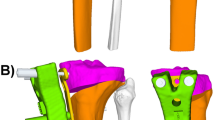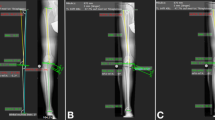Abstract
Purpose
Patient-specific instruments (PSIs) are helpful tools in high tibial osteotomy (HTO) in patients with symptomatic varus malalignment of the mechanical leg axis. However, the precision of HTO can decrease with malpositioned PSI. This study investigates the influence of malpositioned PSI on axis correction, osteotomy, and implant placement.
Methods
With a mean three-dimensional (3D) model (0.8° varus), PSI-navigated HTOs were computer simulated. Two different guide designs, one with stabilising hooks and one without, were used. By adding rotational and translational offsets of different degrees, wrong placements of PSI were simulated. After 5° valgisation of the postoperative mechanical axis, the distance between joint-plane and osteotomy screws, respectively, were measured. The same simulations were performed in a patient with varus deformity (7.4° varus).
Results
In the mean 3D model, the postoperative mechanical axis was within 3.9°–4.5° valgus with mean value of 4.1° ± 0.1° (correct axis 4.2° valgus). Surgical failure concerning osteotomy occurred in 17 of 76 HTOs. Significantly safer screw placement was observed using PSI with stabilising hooks (p = 0.012). In the case of the 3D model with 7.4° varus deformity, the postoperative mechanical axis was within 3.2°–3.9° valgus with mean value of 3.8° ± 0.2° (correct axis 3.9° valgus). Surgical failure concerning osteotomy occurred in 3 of 38 HTOs. Screws were always within the safety distance.
Conclusion
The clinical relevance of the presented study is that malpositioning of a PSI within the possible degrees of freedom does not have a relevant influence on the axis correction. The most vulnerable plane for surgical failure is the sagittal plane, wherefore the treating surgeon should verify correct guide placement to prevent surgical failure, particularly in this plane.
Level of evidence
III.








Similar content being viewed by others
References
Albrecht T, Luthi M, Gerig T, Vetter T (2013) Posterior shape models. Med Image Anal 17:959–973
Brinkman JM, Lobenhoffer P, Agneskirchner JD, Staubli AE, Wymenga AB, van Heerwaarden RJ (2008) Osteotomies around the knee: patient selection, stability of fixation and bone healing in high tibial osteotomies. J Bone Joint Surg Br 90:1548–1557
DePuy Synthes (2017) TomoFix Medial High Tibial Plate (MHT). Surgical technique. DSEM/TRM/0115/0288(3)
El-Azab H, Glabgly P, Paul J, Imhoff AB, Hinterwimmer S (2010) Patellar height and posterior tibial slope after open- and closed-wedge high tibial osteotomy: a radiological study on 100 patients. Am J Sports Med 38:323–329
Fujisawa Y, Masuhara K, Shiomi S (1979) The effect of high tibial osteotomy on osteoarthritis of the knee. An arthroscopic study of 54 knee joints. Orthop Clin North Am 10:585–608
Fürnstahl P, Schweizer A, Graf M, Vlachopoulos L, Fucentese S, Wirth S et al (2016) Surgical treatment of long-bone deformities: 3D preoperative planning and patient-specific instrumentation. Computational radiology for orthopaedic interventions. Springer, New York, pp 123–149
Hasan K, Rahman QA, Zalzal P (2015) Navigation versus conventional high tibial osteotomy: systematic review. SpringerPlus 4:271
Hernigou P, Medevielle D, Debeyre J, Goutallier D (1987) Proximal tibial osteotomy for osteoarthritis with varus deformity. A ten to thirteen-year follow-up study. J Bone Joint Surg Am 69:332–354
Jo HS, Park JS, Byun JH, Lee YB, Choi YL, Cho SH et al (2018) The effects of different hinge positions on posterior tibial slope in medial open-wedge high tibial osteotomy. Knee Surg Sports Traumatol Arthrosc 26:1851–1858
Lutzner J, Gross AF, Gunther KP, Kirschner S (2010) Precision of navigated and conventional open-wedge high tibial osteotomy in a cadaver study. Eur J Med Res 15:117–120
Munier M, Donnez M, Ollivier M, Flecher X, Chabrand P, Argenson JN et al (2017) Can three-dimensional patient-specific cutting guides be used to achieve optimal correction for high tibial osteotomy? Pilot study. Orthop Traumatol Surg Res 103:245–250
Ozel O, Yucel B, Mutlu S, Orman O, Mutlu H (2017) Changes in posterior tibial slope angle in patients undergoing open-wedge high tibial osteotomy for varus gonarthrosis. Knee Surg Sports Traumatol Arthrosc 25:314–318
Perez-Mananes R, Burro JA, Manaute JR, Rodriguez FC, Martin JV (2016) 3D surgical printing cutting guides for open-wedge high tibial osteotomy: do it yourself. J Knee Surg 29:690–695
Vlachopoulos L, Schweizer A, Meyer DC, Gerber C, Fürnstahl P (2016) Three-dimensional corrective osteotomies of complex malunited humeral fractures using patient-specific guides. J Shoulder Elbow Surg 25:2040–2047
Weigelt L, Fürnstahl P, Hirsiger S, Vlachopoulos L, Espinosa N, Wirth SH (2017) Three-dimensional correction of complex ankle deformities with computer-assisted planning and patient-specific surgical guides. J Foot Ankle Surg 56:1158–1164
Yang JC, Chen CF, Luo CA, Chang MC, Lee OK, Huang Y et al (2018) Clinical experience using a 3D-printed patient-specific instrument for medial opening wedge high tibial osteotomy. Biomed Res Int 2018:9246529
Zheng P, Xu P, Yao Q, Tang K, Lou Y (2017) 3D-printed navigation template in proximal femoral osteotomy for older children with developmental dysplasia of the hip. Sci Rep 7:44993
Funding
No funding.
Author information
Authors and Affiliations
Corresponding author
Ethics declarations
Conflict of interest
The authors declare that they have no competing interests.
Ethical approval
The local ethical committee approved this study (Zurich Cantonal Ethics Commission, req-2019-0032).
Additional information
Publisher’s Note
Springer Nature remains neutral with regard to jurisdictional claims in published maps and institutional affiliations.
Rights and permissions
About this article
Cite this article
Jud, L., Fürnstahl, P., Vlachopoulos, L. et al. Malpositioning of patient-specific instruments within the possible degrees of freedom in high-tibial osteotomy has no considerable influence on mechanical leg axis correction. Knee Surg Sports Traumatol Arthrosc 28, 1356–1364 (2020). https://doi.org/10.1007/s00167-019-05432-3
Received:
Accepted:
Published:
Issue Date:
DOI: https://doi.org/10.1007/s00167-019-05432-3




